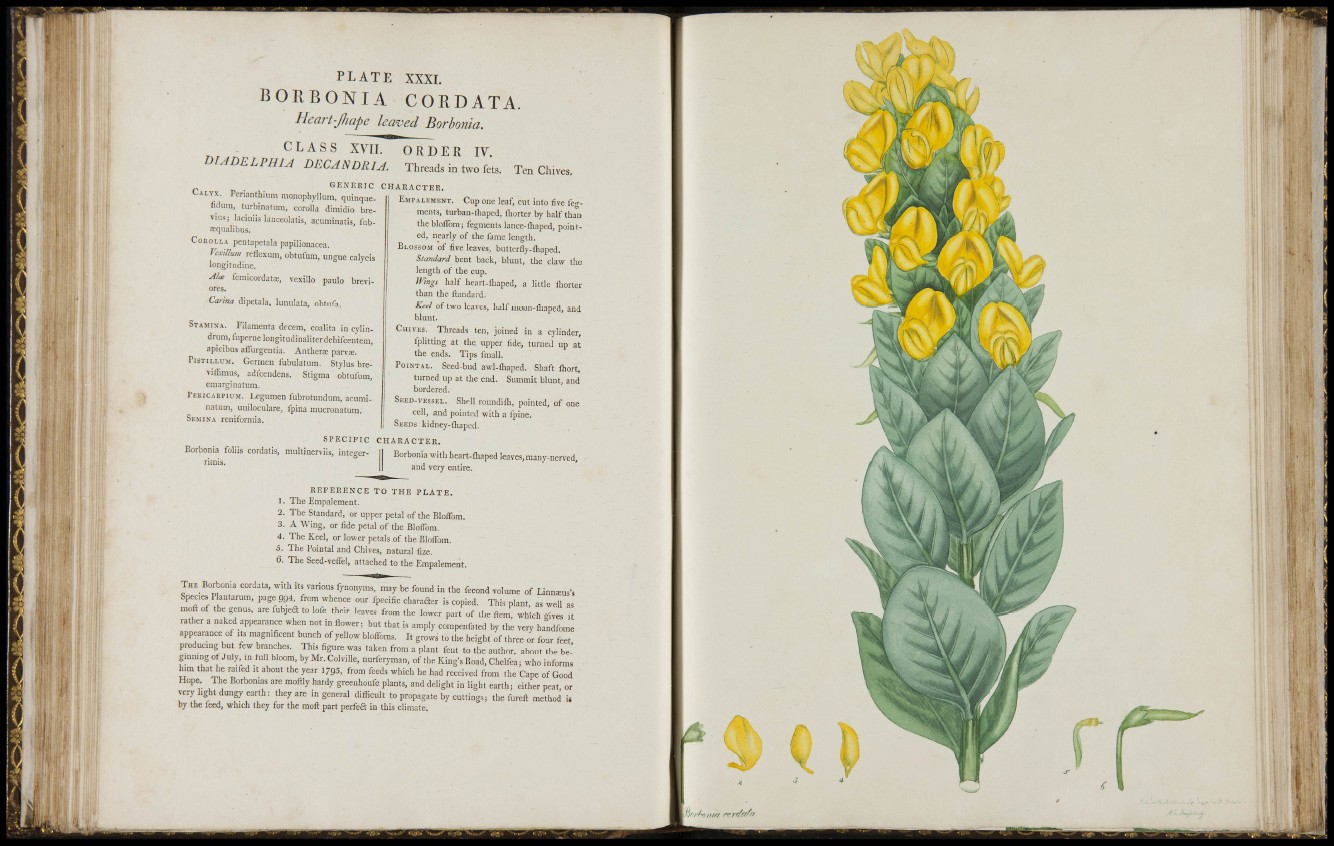
1 i
. " .1 •
T"
.Ml
R -
M
JII
•g3 ' l'i' -1
1 >
Î ; IfSsi'.
. ' r
1
' 1
1 ii'!:''
f '
•y
S -,
! > '
i; 1
PLATE XXXL
B O R B O N I A CORDATA.
Heart-Jìiape leaved Borbonia.
CLASS XVII.
DIADELPHIA DECA N DR I A.
GENERIC
CALYX. Perianthiiim monophvllum, quinquefidura,
turbinafum, corolla dimidio brevuis;
laciiiiis lanceolatis, acuminatis, fubcequalibus.
COKOLLA pentapetala papllionacea.
VcxU/um reflexum, obtufum, ungue calycis
longitudine.
femicordata;, vexillo paulo breviores.
Carina dipelala, lunulata, obtufa.
STAMINA. Filamenta decern, coalita in cylindriim,
luperne longitudinaliterdehifcentem,
apicibus aiTurgentia. Antherae parva:.
PISTILLUM. Gerrnen iubulatum. Stylus brevillmms,
adfcendens. Stigma obtulum,
emarginatura.
PEKICAKPIUM. Legumen fubrotuiidum, acuminatum,
uniloculare, fpina mucronatum.
SEMINA reniformia.
S P E C I F I C
Borbonia foliis cordatis, multinerviis, integerrimis.
O R D E R IV.
Threads in two fets. Ten Chives.
CHARACTER.
EMPALEMENT. Cup one leaf, cut into five fegments,
turban-lhaped, ihorter by half than
the bloffom; fegments iance-fliaped, pointed,
nearly of the fame length.
BLOSSOM of five leaves, butterfly-fliaped.
Standard bent back, bluut, the claw the
l e n g t h of the cup.
IVmgs half heart-fliaped, a little lliorter
than the ftandard.
Keel of two leave,s, half moon-fliaped, and
blunt.
CHIVES. Threads ten, joined in a cylinder,
f p l i t t i n g at the upper fide, turned up at
the ends. Tips fmall.
POINTAL. Seed-bud awl-fliaped. Shaft ihort,
turned up at the end. Summit blunt, and
bordered.
SEED-VESSEL. Shell roundifli, pointed, of one
cell, and pointed with a fpine.
SEEDS kidney-fliaped.
CHARACTER.
Borbonia with heart-fliaped leaves,many-nerved,
and very entire.
REFERENCE TO THE PLATE.
1. The Empalement.
2. The Standard, or upper petal of the Bloffom.
3. A Wing, or fide petal of the Bloffom.
4 . The Keel, or lower petals of the Bloflbm.
5. The Pointai and Chives, natural fize.
6. The Seed-veifel, attached to the Empalement.
THE Borbon.a cordata, with its various fynonyms, may be found in the fécond volume of Linnaeus',
Species Plan.arum, page 994 from whence our fpecific charaae r is copied. This plant, as well as
moil of the genus, are fubj e d to lofe their leaves from the lower part of the ftem, which gives it
r a t h e r a naked appearance when not in flower; but that is amply compenfated by the very handfome
appearance of its magnificent bunch of yellow blofloms. It grows to the height of three or four feet
producing but few branches. This figure was taken from a plant feut to the author, about the begmning
of July, in full bloom, by Mr . Colville, nurferyman, of the King' s Road, Chelfea; who informs
^ m that he raifed it about the year 1795, from feeds which he had received from the Cape of Good
Hope. The Borbonias are moffly hardy greenhoufe plants, and delight in light earth; either peat or
very light dungy earth: they are in general difficult to propagate by cuttings; the fureft metiiod is
by the feed, which they for the moil part perfeft in this climate.
rfrr/r/^r/